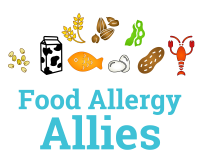Ally (ah-lie) – noun, verb
A person or organization that cooperates with or helps another in a particular activity; to side with or support
Oxford Dictionary
Being an ally to the food allergy community can mean different things to different people. To some, being an ally means advocating for the food allergy community. For others, being an ally is simply adapting to and accommodating the dietary restrictions of others. Regardless of the way being an ally looks like to YOU, here’s five top ways to be an ally in action:
1. Educate yourself
The old saying “knowledge is power” was right. The first step to becoming a food allergy ally is to inform yourself about food allergy-related topics. Ask questions, recognize ignorance, and fact check your sources. Being educated about food allergies not only helps you interact with and accommodate others with food allergies, but can also help ensure their safety in the case of an allergic reaction.
2. Be proactive
The best way to show someone with food allergies that you care is to act ahead of time. Don’t wait until the caterers have already cooked all the cheesy food for the event to notify someone with a dairy allergy. Instead, reach out to guests ahead of time to inquire about any potential dietary restrictions so that both parties can work together to ensure that everyone is accommodated. While many guests with food allergies will likely inquire on their own about the food served, being proactive and asking ahead of time yourself is a much better way to go the extra mile and be an ally.
3. Be inclusive
Many people think that the best way to deal with a kid with a food allergy is to sequester them from all other foods in order to keep them safe. However, this “safety bubble” approach often takes place in the form of separate lunch tables, no special treats, and even exclusion from fun events like birthday parties. Just because a child has a peanut allergy does not mean that they cannot be in the same room as a peanut granola bar. Yes, food allergies are serious and severe. However, with proper guidelines in place (such as no shared foods and lots of hand washing) a kid with food allergies is perfectly capable of mingling with other kids, even with food involved. The best way to keep kids safe and included is to provide allergy-friendly alternatives to the same snacks and treats everyone else is getting, not to enforce exclusive policies.
4. Take precautions
When cooking for someone with food allergies, the utmost caution needs to be taken. A single slip of a spoon could send someone into anaphylactic shock, and ending a fun evening in the Emergency Room turns into a, well, not-so-fun evening. While cross contamination may not be a big deal for a mild food allergy, you should always assume a food allergy is severe unless explicitly told otherwise. Safe cooking precautions include using clean utensils, clean cooking surfaces (cutting boards, grills, counters, pans), clean hands, and safe ingredients. Beyond food preparation at home, precautions also need to be taken at restaurants to inform the waiter, manager, and chef about the food allergy.
5. Be an advocate
Now that you know how to be a food allergy ally, spreading this information to others is the next step. Advocating for the food allergy community helps keep everyone safe, included, and accommodated. Be an ally, be an advocate, and most importantly, be a friend.


Great tips!
LikeLike